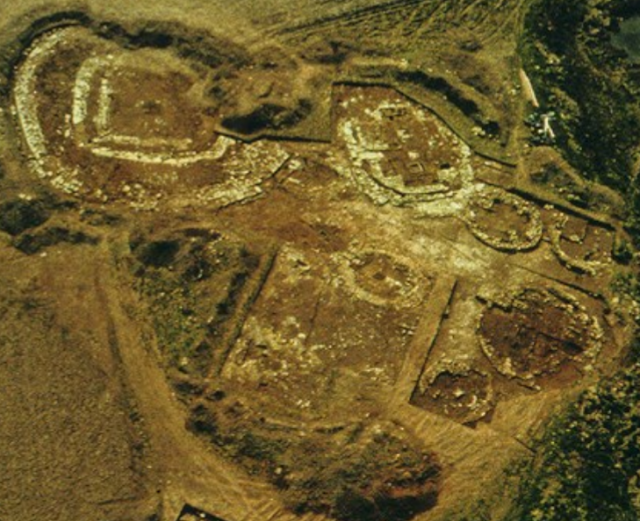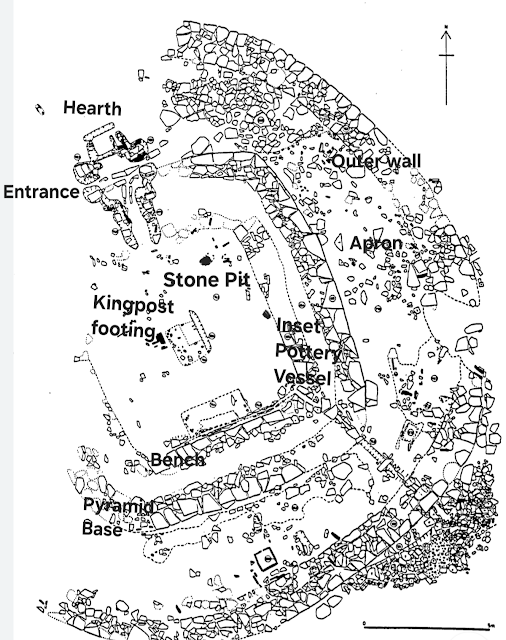Barnhouse
Barnhouse
When the honour of the title UNESCO World Heritage Site was bestowed on Orkney, the two stone circles, Stones of Stenness, Ring of Brodgar, and the Maeshowe Chambered Cairn were the only known, or at least best known, Neolithic monuments at the Brodgar peninsula immediate area.
Since then excavation has uncovered two further sites.
These are Barnhouse, a group of small buildings on the shore of Harray Loch, and the Ness of Brodgar, a huge group of Neolithic buildings nearby. Both these sites inspire us to revise our existing view of how Stone Age people lived and thought.
Barnhouse is close to the Stones of Stenness, and the Maeshowe Cairn, and it sits across the causeway between Lochs Harray and Stenness, from the Ness of Brodgar, and the Ring of Brodgar.
Location plan of Barnhouse, and the Stones of Stenness.
It was discovered and excavated by Colin Richards between 1985 and 1991, and Collin was not aware, at the time that structures he found there would be directly relatable with the huge complex that was to be found at the Ness of Brodgar in 2003.
None of these Barnhouse buildings has the obvious sense of permanence that dwellings at Skara Brae, or the Knap of Howar have. They are short lived structures, often repaired, and rebuilt, and they date from different times throughout the duration of the settlement.
It seems unlikely that the walls of these structures at Barnhouse were ever much more than a few courses high, and a reasonable possibility is that most of these buildings, with the exception of Structures 2 and 8, may have been Teepee- or dome-like timber-framed structures covered with animal skin, reed/thatch, or turves.
Anybody who has lived in Orkney through a normal Orkney winter will recognise that such light structures as these clearly represent, would not survive, or enable their inhabitants to survive, in an Orkney winter of lashing rain and ferocious gales.
Two structures at Barnhouse, 2 and 8, draw direct parallels with those found later at the Ness of Brodgar. The smaller of the two is Structure 2, a rectangular building, the design of which is known as a “piered building”, as it has stone-built pier-like projections coming out from the mid-points of both of its longer, opposing walls. This design strategy is repeated often, at the Ness of Brodgar.
The other building that bears comparison between the two sites is Structure 8, a large square building within a circular enclosure. Structure 10 at the Ness of Brodgar is also more or less square, and may have been built using similar techniques to those employed for Structure 8 at Barnhouse.
Structure 2, the piered structure at Barnhouse was in use for the longest period there, and it was probably built with the intention that it endure for a while, making it clearly an important building.
The carbon dated samples tested from Barnhouse all essentially pre-date 3000BC, and suggest that the site was only in use for a relatively short period of time. 12 samples, Charred grains and charcoal are broadly dated to between 3650BC and 2870BC.
Gullies running through the site are cut into the ground surface. These are likely to have been useful for removal of summer rain from the site, but useless in winter. Colin Richards, who excavated the site, says that the numerous circular structures, here, with hearth like features in them were frequently rebuilt, suggesting that they may have may have been abandoned for winter, and refurbished in spring. The presence of upright stone slabs set into the ground in the piered structure, Structure 2, suggests, that this may have been a dormitory. An ephemeral feature outside the entrance to Structure 2 may have been a latrine with a urinal and toilet seat over a simple drainage ditch.
Good evidence in the large feature, Structure 8 suggests that this was a square pyramid shaped building within a sheltering, encircling wall. The wall surround was to protect people on the apron around the building, but more particularly to protect a fire outside the entrance to the structure which served as a sweat Lodge. A light timber framework covered the interior, resting on and attached to a king post in the centre of the building. An inner wall of stone edging served as seating for the participants of the sweat lodge ceremony. A small horde of stones for heating and wetting to create the steam remained, along with a pot set into the ground to store the water and a small pinch pot to carry water from the storage pot to the Stones.
The buildings at Barnhouse are fragile in nature and it is very likely that many more similar structures were once on this shore of Harray Loch , but have since been destroyed by modern agriculture.











Comments
Post a Comment